13 November 2022
A Geological Miscellany, by G.Y. Craig & E.J. Jones
 A fun, if a little musty, compendium of random writings about geology and geologists from a wide variety of sources, excerpted and packed together into a slim paperback volume. It begins with Mark Twain and concludes with Russell Baker, and there are hundreds of entries in between – some poems, some short essays, some clipped correspondence, some newspaper articles, and so on. It’s miscellaneous, as the title suggests. Many of these are interesting from the perspective of illumination of past working conditions among geologists – persnickety government-issued instructions for maintaining a field camp in New Zealand, for instance, or formal letters telling the staff paleontologist that he’d better damned well show up for work. Others could be categorized as whimsy, some of it in the spirit of goofy inspiration during a dull moment, or the intentional letting-down-of-one’s-hair that accompanied boozy meetings of the Pick and Hammer Club. Several menus are included, of bygone feasts hosted by the Geological Society of London with roasted turtles and pigeons and turbots and eels and dozens of other options. The book is the sort of thing to keep on one’s bedside table as light reading before bed, a small bite at a time, nothing so meaty as a true “chapter.” But because of its heavy emphasis on the historical written record, stretching back to the founding of geology as a discipline in the stratified, sexist western Europe of yore, the people being discussed are even more starkly white and male than geology’s present-day lamentable lack of diversity. Because it carries this sense of “that’s what a geologist is,” I’m not sure I’d recommend it, but there are enough little gems of humor in here, separate from the identity of the humans that produced them, that I could see gleaning out a few of the most poignant quips for general consumption – I’m thinking a geo-poetry reading, or some such. Even William Smith contributed a funny little poem!
A fun, if a little musty, compendium of random writings about geology and geologists from a wide variety of sources, excerpted and packed together into a slim paperback volume. It begins with Mark Twain and concludes with Russell Baker, and there are hundreds of entries in between – some poems, some short essays, some clipped correspondence, some newspaper articles, and so on. It’s miscellaneous, as the title suggests. Many of these are interesting from the perspective of illumination of past working conditions among geologists – persnickety government-issued instructions for maintaining a field camp in New Zealand, for instance, or formal letters telling the staff paleontologist that he’d better damned well show up for work. Others could be categorized as whimsy, some of it in the spirit of goofy inspiration during a dull moment, or the intentional letting-down-of-one’s-hair that accompanied boozy meetings of the Pick and Hammer Club. Several menus are included, of bygone feasts hosted by the Geological Society of London with roasted turtles and pigeons and turbots and eels and dozens of other options. The book is the sort of thing to keep on one’s bedside table as light reading before bed, a small bite at a time, nothing so meaty as a true “chapter.” But because of its heavy emphasis on the historical written record, stretching back to the founding of geology as a discipline in the stratified, sexist western Europe of yore, the people being discussed are even more starkly white and male than geology’s present-day lamentable lack of diversity. Because it carries this sense of “that’s what a geologist is,” I’m not sure I’d recommend it, but there are enough little gems of humor in here, separate from the identity of the humans that produced them, that I could see gleaning out a few of the most poignant quips for general consumption – I’m thinking a geo-poetry reading, or some such. Even William Smith contributed a funny little poem!
12 November 2022
Catastrophes and Lesser Calamities, by Tony Hallam
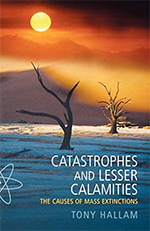 This is a thoughtful volume on mass extinctions written for the novice. One thing I really liked about this book is that it was written very clearly from the mind of a skeptical scientist who is conscientious about explaining each step in his thinking while explaining fairly complicated, murky stuff for a lay audience. Hallam succeeds magnificently in defining ideas first, and only later attaching jargon or terminology to the concept. I really liked the organization of the book, too – rather than the typical march through mass dying through time (i.e., a chronological approach), Hallam organizes his discussion around the various proposed causes of mass extinction, and explores each of those in depth, citing evidence from the Big Five and other events in Earth history that both support and weaken the causative hypotheses. Going at it this way puts a different emphasis on thinking about mass extinctions – it’s a mechanistic approach rather than a historical whodunnit. I learned a lot, and particularly appreciated Hallam’s review of the literature on the role of sea level change in driving mass extinction events – something that often gets left out of the discussion when more attention-grabbing topics like ocean anoxia, large igneous provinces and (yes) meteor impacts are also in the mix. All told, it’s a solid, readable book. The one odd note was a four or five page digression into adventure stories while collecting data in remote corners of the world. Hallam’s discussion of the Pleistocene megafauna extinction really influenced my thinking on that issue. This was not one of the “Big Five” but still of keen interest to many given its unusual scope (large terrestrial species) and timing (shortly after humans arrived on various landmasses).
This is a thoughtful volume on mass extinctions written for the novice. One thing I really liked about this book is that it was written very clearly from the mind of a skeptical scientist who is conscientious about explaining each step in his thinking while explaining fairly complicated, murky stuff for a lay audience. Hallam succeeds magnificently in defining ideas first, and only later attaching jargon or terminology to the concept. I really liked the organization of the book, too – rather than the typical march through mass dying through time (i.e., a chronological approach), Hallam organizes his discussion around the various proposed causes of mass extinction, and explores each of those in depth, citing evidence from the Big Five and other events in Earth history that both support and weaken the causative hypotheses. Going at it this way puts a different emphasis on thinking about mass extinctions – it’s a mechanistic approach rather than a historical whodunnit. I learned a lot, and particularly appreciated Hallam’s review of the literature on the role of sea level change in driving mass extinction events – something that often gets left out of the discussion when more attention-grabbing topics like ocean anoxia, large igneous provinces and (yes) meteor impacts are also in the mix. All told, it’s a solid, readable book. The one odd note was a four or five page digression into adventure stories while collecting data in remote corners of the world. Hallam’s discussion of the Pleistocene megafauna extinction really influenced my thinking on that issue. This was not one of the “Big Five” but still of keen interest to many given its unusual scope (large terrestrial species) and timing (shortly after humans arrived on various landmasses).
11 November 2022
How the Mountains Grew, by John Dvorak
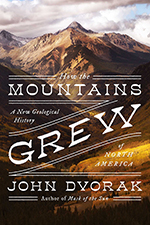 This enjoyable book offers “a new geological history of North America,” summarizing a vast swath of research from many disciplines to expound on the continent’s evolution over deep time. The geographic scope is a little inconsistent – it mainly centers on the Lower 48 United States, but includes bits of Canada and a brief foray into Mexico for the Chicxulub impact crater, but also mentions Hawaii (which though part of the U.S. isn’t part of the continent) while almost entirely ignoring Alaska. But for the areas it focuses on as relevant to telling the story of the continent, it delves into great, highly-specific detail: the kind of detail that appeals greatly to a geoscience outreach nut like me. Specific waterfalls in state parks, specific exit numbers to reach key outcrops, this glacier has retreated by that many miles, and so forth — all this is evidence of a willingness to luxuriate in the level of geographic detail that might put a novice off, but suggests to me that Dvorak really knows what he’s talking about. Then again, there were some errors that seemed preventable: placing India in the northern hemisphere at the time of the Deccan Traps’ eruption, mistakenly referring to the Coastal Plain as “the Piedmont,” indicating that Mt. Moran’s 800 Ma mafic dike was intruded “near the end of the Paleozoic.” Maybe these are pretty minor in the grand scheme of things – the book is PACKED with details, and it’s probably inevitable a few of them might not be exactly on target. I found much to appreciate in How The Mountains Grew: new fossils to check out, new parks to put on my “must visit” list, new perspectives on large scale teleconnections between disparate phenomena. I’d never heard of Dvorak’s writing prior to seeing this volume pop up in a “related books” algorithm on AbeBooks.com, and I’m so glad it did. Turns out he has three other titles, which I just ordered — and look forward to reporting on them to you here someday!
This enjoyable book offers “a new geological history of North America,” summarizing a vast swath of research from many disciplines to expound on the continent’s evolution over deep time. The geographic scope is a little inconsistent – it mainly centers on the Lower 48 United States, but includes bits of Canada and a brief foray into Mexico for the Chicxulub impact crater, but also mentions Hawaii (which though part of the U.S. isn’t part of the continent) while almost entirely ignoring Alaska. But for the areas it focuses on as relevant to telling the story of the continent, it delves into great, highly-specific detail: the kind of detail that appeals greatly to a geoscience outreach nut like me. Specific waterfalls in state parks, specific exit numbers to reach key outcrops, this glacier has retreated by that many miles, and so forth — all this is evidence of a willingness to luxuriate in the level of geographic detail that might put a novice off, but suggests to me that Dvorak really knows what he’s talking about. Then again, there were some errors that seemed preventable: placing India in the northern hemisphere at the time of the Deccan Traps’ eruption, mistakenly referring to the Coastal Plain as “the Piedmont,” indicating that Mt. Moran’s 800 Ma mafic dike was intruded “near the end of the Paleozoic.” Maybe these are pretty minor in the grand scheme of things – the book is PACKED with details, and it’s probably inevitable a few of them might not be exactly on target. I found much to appreciate in How The Mountains Grew: new fossils to check out, new parks to put on my “must visit” list, new perspectives on large scale teleconnections between disparate phenomena. I’d never heard of Dvorak’s writing prior to seeing this volume pop up in a “related books” algorithm on AbeBooks.com, and I’m so glad it did. Turns out he has three other titles, which I just ordered — and look forward to reporting on them to you here someday!
12 October 2022
Geopedia, by Marcia Bjornerud
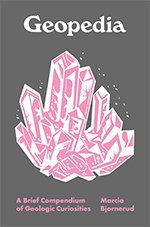 My favorite popularizer of modern geology is Marcia Bjornerud. Her sensibility for what is interesting and important matches very nicely with my own – I feel she is a kindred spirit, though one infinitely more talented with language than I am. Lovers of geology found much to delight them in Reading the Rocks. She took the geological into the realm of the philosophical and political in Timefulness. This book (her third, a “pandemic project”) is a fun, trim little compendium of geological words. It relishes the exotic origins and fun flavors of geological jargon, and explores each word or phrase in a page or two, teasing out the big “take home” message in short order, and somehow managing to deliver cogent, coherent, condensed summaries of geological big ideas with a balance of economy and ebullience. Perhaps the best example of this is the short little “taglines” for each entry:
My favorite popularizer of modern geology is Marcia Bjornerud. Her sensibility for what is interesting and important matches very nicely with my own – I feel she is a kindred spirit, though one infinitely more talented with language than I am. Lovers of geology found much to delight them in Reading the Rocks. She took the geological into the realm of the philosophical and political in Timefulness. This book (her third, a “pandemic project”) is a fun, trim little compendium of geological words. It relishes the exotic origins and fun flavors of geological jargon, and explores each word or phrase in a page or two, teasing out the big “take home” message in short order, and somehow managing to deliver cogent, coherent, condensed summaries of geological big ideas with a balance of economy and ebullience. Perhaps the best example of this is the short little “taglines” for each entry:
Examples:
Yardang Gone with the wind
Jökulhlaup Breaking the ice
Bioturbation The worm churns
I read the whole book (it’s only 168 pages) in two days, and I’m very keen on reading it again soon. I think I’ll quote passages from it when discussing komatiites and zircons, eclogite and pseudotachylyte. To me, one of the most striking passages was the entry on pedogenesis, the making of soil. You might expect an entry on dirt to be boring as hell, but she frames it in the context of how precious a set of circumstances are required to make soil – circumstances that cannot be expected on other planets, and only induced at great expense over vast spans of time. Those who would glibly “TERRAFORM MARS” would do well to spend ten minutes reading this trim little entry, which effortlessly guts their oversimplified vision. Earth makes earth very well, and we would do well to appreciate our home and conserve it rather than make a go for Plan(et) B. Marcia recently visited with my students via Zoom, and read us two passages from Geopedia: one on the Tully Monster, and another on a favorite topic: boudinage, which she illustrated using imagery from this blog! 🙂
11 October 2022
Book report
The Great Derangement: Climate Change and the Unthinkable, by Amitav Ghosh
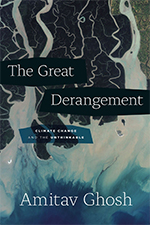 Marcia Bjornerud put me onto this one. An interesting book that explores the roots and results of our response to climate change. The author, an acclaimed Indian novelist, is particularly interested in the unwillingness of artists and novelists to grapple with climate change, citing this failure to engage as evidence of a great derangement in society: society’s awareness of climate change but unwillingness to change our ways or really even talk about it much. To Ghosh, novelists and other literary artists are critical to helping society process the issues of the moment. Where are the great climate change novels, he asks? Or is writing about climate change automatically writing something that is not a great novel? Where does the split between science fiction (or even “cli fi”) and the rest of the literary world come from? What forces maintain it? Are novelists as culpable in perpetuating the climate-harming status quo as the politicians who are so blatantly in the pocket of the fossil fuel industry? Ghosh is keen in particular to explore the Asian side of the response (or lack thereof), examining the issue from the perspective of India, its colonial history, its population, its economic development, and its literature. To me, this intentional perspective-setting is one of the most important things about Ghosh’s book. It allows westerners like me clear insight into the various factors that influence the thinking of people who dwell in a culture that stems from very different roots than my own, has been strongly shaped by colonial forces, but will suffer the impacts of climate change every bit as acutely despite being far less culpable for emitting the causative carbon atoms in the first place.
Marcia Bjornerud put me onto this one. An interesting book that explores the roots and results of our response to climate change. The author, an acclaimed Indian novelist, is particularly interested in the unwillingness of artists and novelists to grapple with climate change, citing this failure to engage as evidence of a great derangement in society: society’s awareness of climate change but unwillingness to change our ways or really even talk about it much. To Ghosh, novelists and other literary artists are critical to helping society process the issues of the moment. Where are the great climate change novels, he asks? Or is writing about climate change automatically writing something that is not a great novel? Where does the split between science fiction (or even “cli fi”) and the rest of the literary world come from? What forces maintain it? Are novelists as culpable in perpetuating the climate-harming status quo as the politicians who are so blatantly in the pocket of the fossil fuel industry? Ghosh is keen in particular to explore the Asian side of the response (or lack thereof), examining the issue from the perspective of India, its colonial history, its population, its economic development, and its literature. To me, this intentional perspective-setting is one of the most important things about Ghosh’s book. It allows westerners like me clear insight into the various factors that influence the thinking of people who dwell in a culture that stems from very different roots than my own, has been strongly shaped by colonial forces, but will suffer the impacts of climate change every bit as acutely despite being far less culpable for emitting the causative carbon atoms in the first place.
Vesper Flights, by Helen Macdonald
 Helen Macdonald wrote the critically acclaimed memoir H is for Hawk some years ago. It was good, so I was pleased to see this compilation released in 2020. Vesper Flights is a collection of essays, some of which have been previously published in various periodicals. Most of them involve birds, but all involve the human relationship to the natural world. Macdonald is a talented, instinctive essayist, and I found that I enjoyed Vesper Flights more than H is for Hawk because of how tidy and efficient each of these pieces felt. The title pieces is about swifts, which engage in a strange behavior that has them swirling skyward en masse to tremendous heights, gaining a more expansive view with altitude. Macdonald draws a parallel to the human ability to forecast the future, including the looming storm of climate change. Macdonald seems happiest in nature, making minute and detailed observations about ants and orioles and herons and plants. But none of these essays are “just” natural history; each bird or place has some lesson to teach us about ourselves, and the change we have induced in the natural world or the changes the natural world induces in us. Very palatable and digestible, this book would be a great place to start reading Macdonald.
Helen Macdonald wrote the critically acclaimed memoir H is for Hawk some years ago. It was good, so I was pleased to see this compilation released in 2020. Vesper Flights is a collection of essays, some of which have been previously published in various periodicals. Most of them involve birds, but all involve the human relationship to the natural world. Macdonald is a talented, instinctive essayist, and I found that I enjoyed Vesper Flights more than H is for Hawk because of how tidy and efficient each of these pieces felt. The title pieces is about swifts, which engage in a strange behavior that has them swirling skyward en masse to tremendous heights, gaining a more expansive view with altitude. Macdonald draws a parallel to the human ability to forecast the future, including the looming storm of climate change. Macdonald seems happiest in nature, making minute and detailed observations about ants and orioles and herons and plants. But none of these essays are “just” natural history; each bird or place has some lesson to teach us about ourselves, and the change we have induced in the natural world or the changes the natural world induces in us. Very palatable and digestible, this book would be a great place to start reading Macdonald.
This is Your Brain on Plants, by Michael Pollan
 A fairly typical Michael Pollan book – digging into plant science and lore and exploring the botanical world’s relationship to the human world. This volume is very much akin to The Botany of Desire, with the caveat that it’s much more focused on drugs. Specifically, he focuses on opium, caffeine, and mescaline – compounds produced respectively by a poppy, the coffee and tea bushes, and a small cactus. The typical Pollan formula is to grow a plant, write about its history and his care of it, then consuming it and noting the results. In this case, in the 1990s, he grows opium poppies, which were then sold out of commercial seed catalogs, and ultimately consumes a tea he brews from the seeds. This is, according to the letter of the law, illegal, despite the fact that growing the seeds for aesthetics in your garden is totally fine. He gets very paranoid about the fraught legal situation he has engendered, and much of the piece centers on the War on Drugs and how the federal government could have confiscated his house, etc. The caffeine section is perhaps the most interesting, since caffeine is the mostly widely used “drug” in the world – a stimulant that something like half the world’s population is addicted to. And Pollan inverts his usual formula by denying himself caffeine, rather than consuming it. He then documents the brain fog and lethargy that result, and after three months of quitting, what it feels like to go back to drinking coffee again. The mescaline section is more anthropological, investigating Native American use of the peyote cactus as part of tribal-identity-affirming religious practices, and what it means for a white guy like him to nose his way into their traditions. The COVID-19 pandemic strikes during the middle of his reporting on mescaline, and it ends up impacting his plans in ways that aren’t really ideal.
A fairly typical Michael Pollan book – digging into plant science and lore and exploring the botanical world’s relationship to the human world. This volume is very much akin to The Botany of Desire, with the caveat that it’s much more focused on drugs. Specifically, he focuses on opium, caffeine, and mescaline – compounds produced respectively by a poppy, the coffee and tea bushes, and a small cactus. The typical Pollan formula is to grow a plant, write about its history and his care of it, then consuming it and noting the results. In this case, in the 1990s, he grows opium poppies, which were then sold out of commercial seed catalogs, and ultimately consumes a tea he brews from the seeds. This is, according to the letter of the law, illegal, despite the fact that growing the seeds for aesthetics in your garden is totally fine. He gets very paranoid about the fraught legal situation he has engendered, and much of the piece centers on the War on Drugs and how the federal government could have confiscated his house, etc. The caffeine section is perhaps the most interesting, since caffeine is the mostly widely used “drug” in the world – a stimulant that something like half the world’s population is addicted to. And Pollan inverts his usual formula by denying himself caffeine, rather than consuming it. He then documents the brain fog and lethargy that result, and after three months of quitting, what it feels like to go back to drinking coffee again. The mescaline section is more anthropological, investigating Native American use of the peyote cactus as part of tribal-identity-affirming religious practices, and what it means for a white guy like him to nose his way into their traditions. The COVID-19 pandemic strikes during the middle of his reporting on mescaline, and it ends up impacting his plans in ways that aren’t really ideal.
Hawks in Flight, by Pete Dunne, David Sibley, and Clay Sutton
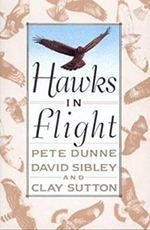 Fall is raptor migration season. On the east coast, a lot of raptors (hawks, falcons, eagles, etc.) utilize updrafts along our northeast/southwest-trending mountain ridges as a free source of energy to stay aloft, cruising toward warmer climes in great numbers. Hawk Mountain, Pennsylvania is a nationally-renowned location for viewing migrating raptors in the fall, but closer to me is the observation station at Rockfish Gap. I’ve been visiting their hawk watch regularly since I moved to Charlottesville, and this past month, I volunteered at an open house there, representing the Piedmont Virginia Bird Club. Hawk watching at one of these ridge sites is a curious activity: most of the birds are high up, and can only be identified (a) through optical magnification and (b) with a fair amount of experience. Seasoned hawk watchers use fairly subtle aspects of a bird’s “gestalt” such as how prominent the head is relative to the tail, or whether the trailing edge of the wing has a more “S” shaped profile vs. a straighter line. Do its shoulders appear “hunched”? Does it flap rapidly, languidly, or powerfully? These are not obvious features to the novice, and while I’m no pro, I have learned a lot from spending time among the experienced hawk watchers. I’m better at it now than I was a year ago. And this book took my conceptual understanding to a new level: Detailed, evocative writing by Pete Dunne about the sorts of features to be receptive to are paired with black and white drawings by illustrator David Sibley, and a substantial section of photographs by Clay Sutton. I feel more confident – though I’ll admit that even this morning, a raptor flew over and I got to look at it for all of two seconds, failing to apply some of the basic lessons imparted by Hawks in Flight. Oh well, I’ll keep trying!
Fall is raptor migration season. On the east coast, a lot of raptors (hawks, falcons, eagles, etc.) utilize updrafts along our northeast/southwest-trending mountain ridges as a free source of energy to stay aloft, cruising toward warmer climes in great numbers. Hawk Mountain, Pennsylvania is a nationally-renowned location for viewing migrating raptors in the fall, but closer to me is the observation station at Rockfish Gap. I’ve been visiting their hawk watch regularly since I moved to Charlottesville, and this past month, I volunteered at an open house there, representing the Piedmont Virginia Bird Club. Hawk watching at one of these ridge sites is a curious activity: most of the birds are high up, and can only be identified (a) through optical magnification and (b) with a fair amount of experience. Seasoned hawk watchers use fairly subtle aspects of a bird’s “gestalt” such as how prominent the head is relative to the tail, or whether the trailing edge of the wing has a more “S” shaped profile vs. a straighter line. Do its shoulders appear “hunched”? Does it flap rapidly, languidly, or powerfully? These are not obvious features to the novice, and while I’m no pro, I have learned a lot from spending time among the experienced hawk watchers. I’m better at it now than I was a year ago. And this book took my conceptual understanding to a new level: Detailed, evocative writing by Pete Dunne about the sorts of features to be receptive to are paired with black and white drawings by illustrator David Sibley, and a substantial section of photographs by Clay Sutton. I feel more confident – though I’ll admit that even this morning, a raptor flew over and I got to look at it for all of two seconds, failing to apply some of the basic lessons imparted by Hawks in Flight. Oh well, I’ll keep trying!
_______________________________
* I also re-read Patrick O’Brian’s Master and Commander, and Peter Brannen’s The Ends of the World over the past couple of weeks – both as good as ever!
16 September 2022
Friday fold: isoclinal limestone near Harrisonburg
This weekend, my family and I traveled to a little agrotainment complex north of Harrisonburg, Virginia, a joint called Back Home On The Farm. It featured a corn maze, hayrides, petting zoo, apple cider donuts, and pumpkin picking. All typical fall frolic; good clean fun.
But there were also big blocks of limestone everywhere on the property. I did my best to check them all out. I was mainly scanning for stromatolites, which occur with some regularity in the Conococheague Formation. This site was mapped as New Market + Lincolnshire + Edinburg Formations, but these blocks look most like the Conococheague to me.
No stromatolites, but I did find some nice tight folding in one block:
This is pretty intense deformation of originally planar beds, and I’m tempted to think it might be soft sediment deformation based on the massive overlying bed (which is undeformed). But it could also be a weak zone that crumpled during Alleghanian mountain building. Your thoughts?
Happy Friday to you!
5 September 2022
Book report
Great Expectations, by Charles Dickens
 I’ve recently enjoyed David Copperfield and A Tale of Two Cities, so I re-read Great Expectations. Somehow we ended up with three copies of it in our house. It is what it is, a solid novel by a talented writer. The great strength of Dickens, I’ve come to appreciate, is his wacky characters – the level of detail in his portraits of these imagined humans is profound, often endearing or revolting, and frequently amusing. Great Expectations had terrific characters in spades – notably Jaggers and Wemmick and Miss Havisham. But the overall arc of the story was far less satisfying than I had grown accustomed to, with Dickens’ other great works so recent in my memory. The fact that Pip never really reaches reconciliation with Estella, Joe, or Biddy seems a real shame, and I found myself feeling both sad for him and also a bit disappointed in him, a sour taste in my mouth as I shut the back cover of the book. Magwich’s end also felt abrupt and unpoetic, with Pip slipping him knowledge about Estella in the old convict’s final moments, and … for what? It felt pointless and distracting to me. And Estella herself – she never grows out of her awful attitude, even when she gains awareness of it. She’s just as mean to Pip in the end as she was in the beginning. Ultimately, I didn’t love this book.
I’ve recently enjoyed David Copperfield and A Tale of Two Cities, so I re-read Great Expectations. Somehow we ended up with three copies of it in our house. It is what it is, a solid novel by a talented writer. The great strength of Dickens, I’ve come to appreciate, is his wacky characters – the level of detail in his portraits of these imagined humans is profound, often endearing or revolting, and frequently amusing. Great Expectations had terrific characters in spades – notably Jaggers and Wemmick and Miss Havisham. But the overall arc of the story was far less satisfying than I had grown accustomed to, with Dickens’ other great works so recent in my memory. The fact that Pip never really reaches reconciliation with Estella, Joe, or Biddy seems a real shame, and I found myself feeling both sad for him and also a bit disappointed in him, a sour taste in my mouth as I shut the back cover of the book. Magwich’s end also felt abrupt and unpoetic, with Pip slipping him knowledge about Estella in the old convict’s final moments, and … for what? It felt pointless and distracting to me. And Estella herself – she never grows out of her awful attitude, even when she gains awareness of it. She’s just as mean to Pip in the end as she was in the beginning. Ultimately, I didn’t love this book.
Termination Shock, by Neil Stephenson
 A novel of humanity reckoning with climate change, rather similar in many regards to Kim Stanley Robinson’s The Ministry for the Future. Both novels feature a middle-aged European woman as protagonist: a bureaucrat for Robinson, and the queen of the Netherlands for Stephenson. Termination Shock distinguishes itself with significantly more action than Ministry, though: there’s more fighting and interpersonal interrelating. The plot is basically this: a wealthy Texan convenes a group of wealthy people who live in low-lying areas of the world to participate in a private geoengineering enterprise, launching sulfur into the stratosphere (reducing the solar energy flux and thus cooling the planet). These people are directly threatened by rising sea level, and they have the means to take action to stop that sea level rise. They do so. Then what? Well, some countries are gratified; others are incensed. The action triggers a counteraction, and the plot drives forward. Stephenson’s great ability is to weave in many strands from life into his novels. This one cites COVID-19, COVID-23, and COVID-25 as recent pandemics that humanity has struggled through; and delves deep into Sikh culture, the feral hog problem in the American South, and China and India’s battle over their border in the Himalaya. He also manages to invoke all kinds of recently-developed technology: Directed-energy weapons (like those that are thought to cause Havana Syndrome), an EMP, and deepfake videos all make appearances, many serving as key turning points in the plot. Drones are EVERYWHERE in this book, thoroughly saturating the near-future imagined by Stephenson. Overall, I felt like this was a solid novel, and I enjoyed reading it. Though fiction, it thoroughly explores the geopolitical ramifications of someone deciding to geoengineer the climate. It wasn’t as impressive as Seveneves, but not as anticlimactic as Cryptonomicon.
A novel of humanity reckoning with climate change, rather similar in many regards to Kim Stanley Robinson’s The Ministry for the Future. Both novels feature a middle-aged European woman as protagonist: a bureaucrat for Robinson, and the queen of the Netherlands for Stephenson. Termination Shock distinguishes itself with significantly more action than Ministry, though: there’s more fighting and interpersonal interrelating. The plot is basically this: a wealthy Texan convenes a group of wealthy people who live in low-lying areas of the world to participate in a private geoengineering enterprise, launching sulfur into the stratosphere (reducing the solar energy flux and thus cooling the planet). These people are directly threatened by rising sea level, and they have the means to take action to stop that sea level rise. They do so. Then what? Well, some countries are gratified; others are incensed. The action triggers a counteraction, and the plot drives forward. Stephenson’s great ability is to weave in many strands from life into his novels. This one cites COVID-19, COVID-23, and COVID-25 as recent pandemics that humanity has struggled through; and delves deep into Sikh culture, the feral hog problem in the American South, and China and India’s battle over their border in the Himalaya. He also manages to invoke all kinds of recently-developed technology: Directed-energy weapons (like those that are thought to cause Havana Syndrome), an EMP, and deepfake videos all make appearances, many serving as key turning points in the plot. Drones are EVERYWHERE in this book, thoroughly saturating the near-future imagined by Stephenson. Overall, I felt like this was a solid novel, and I enjoyed reading it. Though fiction, it thoroughly explores the geopolitical ramifications of someone deciding to geoengineer the climate. It wasn’t as impressive as Seveneves, but not as anticlimactic as Cryptonomicon.
A Short History of Nearly Everything, by Bill Bryson
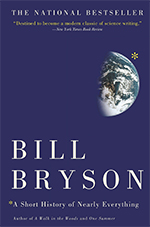 Another re-reading. In popular science, it seems to me that there are relatively few ways that authors choose to tell the story of the universe from beginning until now. What strikes me as worthwhile about Bryson’s attempt is that he did it his way. It’s not a straight-up chronology of events from 13.7 Ga on page one until you and me show up on the last page. And it’s not a “history of science” either – it’s somewhere in between, with the order of topics discussed basically just Bryson’s preferred shuffling of the deck. But what you read in Chapter 12 doesn’t necessarily presage what will be covered in Chapter 13. That keeps it fresh, I think. I hope it goes without saying that Bryson’s wit is as charming here as in any of his other books – he has a very endearing way of writing, grounded in midwestern sensibility but seasoned with British style and snap. I first read A Short History of Nearly Everything shortly after it came out, but I know more now than I did then. And so I found my reading interrupted by stumbling over errors of fact or emphasis – for instance him saying that Hawaii is on a plate boundary, when the coolest thing about that archipelago is the fact that it’s so far from a plate boundary! It’s a pretty chewy tome, but I think worth reading if you haven’t already just for Bryson’s fresh “outsider’s” take on cosmology, Earth science, and everything in between.
Another re-reading. In popular science, it seems to me that there are relatively few ways that authors choose to tell the story of the universe from beginning until now. What strikes me as worthwhile about Bryson’s attempt is that he did it his way. It’s not a straight-up chronology of events from 13.7 Ga on page one until you and me show up on the last page. And it’s not a “history of science” either – it’s somewhere in between, with the order of topics discussed basically just Bryson’s preferred shuffling of the deck. But what you read in Chapter 12 doesn’t necessarily presage what will be covered in Chapter 13. That keeps it fresh, I think. I hope it goes without saying that Bryson’s wit is as charming here as in any of his other books – he has a very endearing way of writing, grounded in midwestern sensibility but seasoned with British style and snap. I first read A Short History of Nearly Everything shortly after it came out, but I know more now than I did then. And so I found my reading interrupted by stumbling over errors of fact or emphasis – for instance him saying that Hawaii is on a plate boundary, when the coolest thing about that archipelago is the fact that it’s so far from a plate boundary! It’s a pretty chewy tome, but I think worth reading if you haven’t already just for Bryson’s fresh “outsider’s” take on cosmology, Earth science, and everything in between.
The Egg, and other stories, by Andy Weir
 I’ve really enjoyed two of Weir’s novels, and to my knowledge this is his first and only collection of short fiction. I listened to it on audiobook. The scientific acumen and technical practicality of Weir’s characters in The Martian and Hail Mary Project are absent in these short stories. These aren’t mini-Martians; they are their own distinct genre for Weir. He treats them differently. They feel like episodes of the Twilight Zone – most building up in a weird and unsettling way toward a “punchline” revelation at the end, recasting all you’ve just read and making you re-examine it with some level of “Aha, now I get it.” That’s the one great strength of this collection, and because it’s a relatively modest total number of stories, I think it would be regretful if I revealed any of the twists here… including one about the Twilight Zone itself…
I’ve really enjoyed two of Weir’s novels, and to my knowledge this is his first and only collection of short fiction. I listened to it on audiobook. The scientific acumen and technical practicality of Weir’s characters in The Martian and Hail Mary Project are absent in these short stories. These aren’t mini-Martians; they are their own distinct genre for Weir. He treats them differently. They feel like episodes of the Twilight Zone – most building up in a weird and unsettling way toward a “punchline” revelation at the end, recasting all you’ve just read and making you re-examine it with some level of “Aha, now I get it.” That’s the one great strength of this collection, and because it’s a relatively modest total number of stories, I think it would be regretful if I revealed any of the twists here… including one about the Twilight Zone itself…
Dreams From My Father, by Barack Obama
 Obama’s first book, written after law school but before being elected to political office: a compelling, readable account of his boyhood and early manhood. It’s anchored with the effort of coming to understand his biological father, who looms large in his life despite the two spending only a week together in Obama’s memory. Obama, the first Black president of the United States, was deeply shaped by childhood experiences in Hawaii and Indonesia, time spent trying to organize people in Chicago for a more vibrant and durable community, and also a key visit, post-Chicago and pre-law-school, to his father’s homeland of Kenya. This singular figure in the American political world has a singular backstory, and this is the book where he lays it all out – circumstances and decisions good, bad, and ugly. The level of self-reflection is extremely refreshing to contemplate – considering his successor in the White House.
Obama’s first book, written after law school but before being elected to political office: a compelling, readable account of his boyhood and early manhood. It’s anchored with the effort of coming to understand his biological father, who looms large in his life despite the two spending only a week together in Obama’s memory. Obama, the first Black president of the United States, was deeply shaped by childhood experiences in Hawaii and Indonesia, time spent trying to organize people in Chicago for a more vibrant and durable community, and also a key visit, post-Chicago and pre-law-school, to his father’s homeland of Kenya. This singular figure in the American political world has a singular backstory, and this is the book where he lays it all out – circumstances and decisions good, bad, and ugly. The level of self-reflection is extremely refreshing to contemplate – considering his successor in the White House.
20 August 2022
Two erratics from coastal Maine
Happy Saturday! Here are two erratics (glacially transported boulders) that I saw last week in coastal Maine. This one shows prominent subparallel striations:
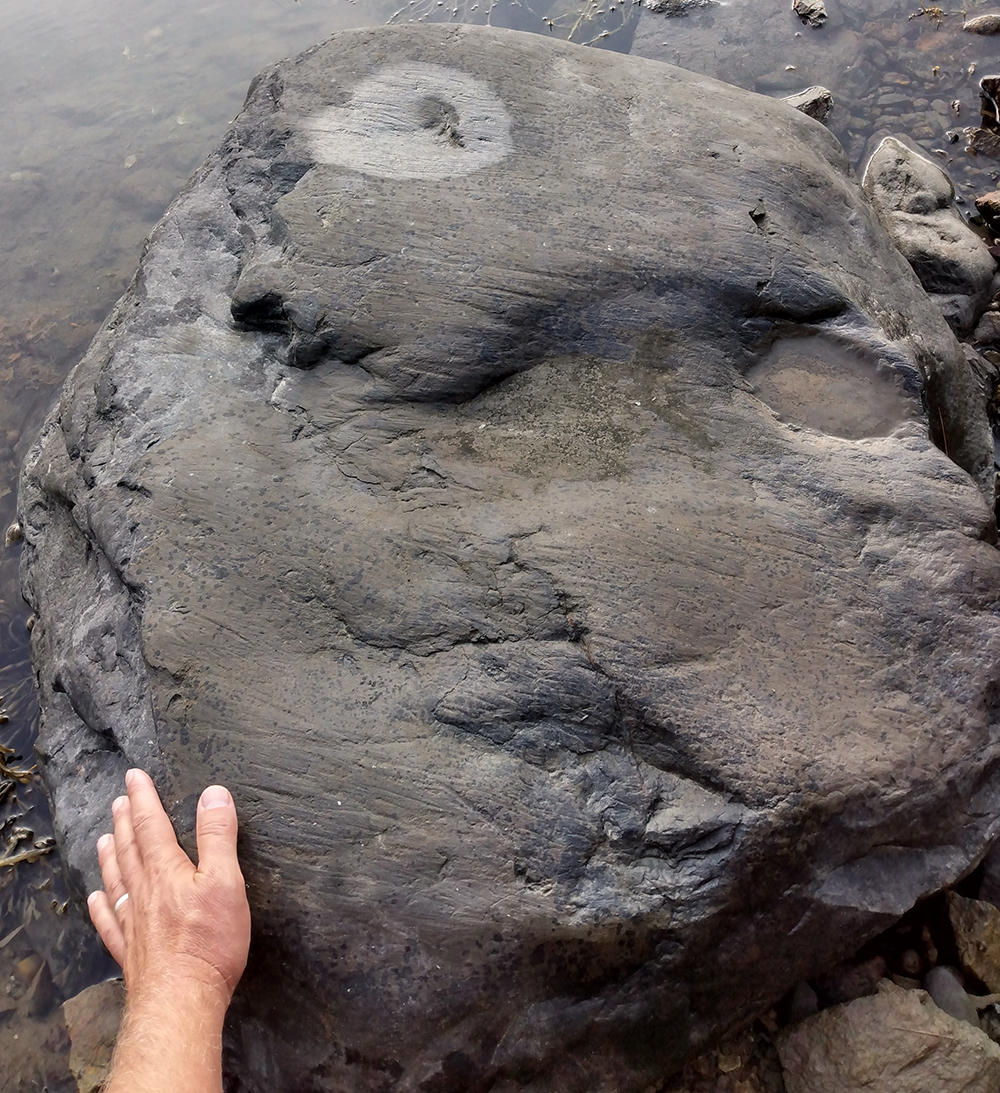
And this one, in the town of Penobscot, next to the greasy spoon called Bagaduce Lunch, shows aligned feldspars that suggest magmatic flow:
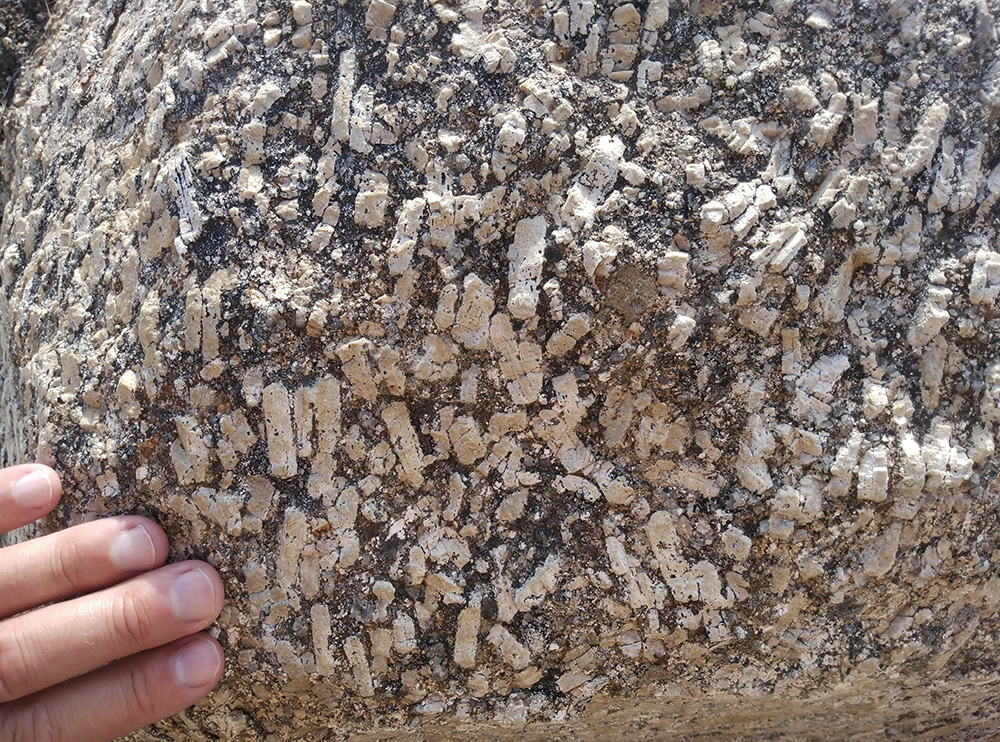
Nothing like a good erratic to get the weekend started off right!
19 August 2022
Second Nature, by Nathaniel Rich
 This volume is a compilation of reporting that author Nathaniel Rich previously published (sometimes in rather different form) in a variety of periodicals, but mainly the New York Times Magazine. The general theme is humanity’s alteration of the natural world, for good or (usually) for ill. The first piece, on West Virginian lawyer Robert Bilott, was the basis of the recent Mark Ruffalo film Dark Waters. Other essays examine a mysterious disease killing Pacific starfish, toxic gas leaks in residential coastal California, artificial (lab cultured) meat, the rewilding of New Orleans in the aftermath of Hurricane Katrina, the tug-of-war of eco-sensitive development in Aspen, Colorado, efforts toward the de-extinction of the passenger pigeon, and more. A trio of pieces examines the impact of sea level rise along the Louisiana coast. Each was a well-reported, well-written read, and collections like this are valuable as tributes to the range of a writer’s interests. It’s mostly glum, partly uncanny, and not especially hopeful. These are interesting times in which to live, and Rich’s book documents some of the reasons why.
This volume is a compilation of reporting that author Nathaniel Rich previously published (sometimes in rather different form) in a variety of periodicals, but mainly the New York Times Magazine. The general theme is humanity’s alteration of the natural world, for good or (usually) for ill. The first piece, on West Virginian lawyer Robert Bilott, was the basis of the recent Mark Ruffalo film Dark Waters. Other essays examine a mysterious disease killing Pacific starfish, toxic gas leaks in residential coastal California, artificial (lab cultured) meat, the rewilding of New Orleans in the aftermath of Hurricane Katrina, the tug-of-war of eco-sensitive development in Aspen, Colorado, efforts toward the de-extinction of the passenger pigeon, and more. A trio of pieces examines the impact of sea level rise along the Louisiana coast. Each was a well-reported, well-written read, and collections like this are valuable as tributes to the range of a writer’s interests. It’s mostly glum, partly uncanny, and not especially hopeful. These are interesting times in which to live, and Rich’s book documents some of the reasons why.
18 August 2022
Quarrying soapstone
Earlier this summer, I was lucky enough to visit a soapstone quarrying operation in Schuyler, Virginia, right on the Albemarle/Nelson County line.
These soapstone bodies are metamorphosed ultramafic intrusions into the Neoproterozoic sedimentary deposits of the Lynchburg Group. The protolith peridotite sill crystallized at ~580 Ma, meaning the host sediments are older than that (but younger than the Grenvillian basement complex that underlies both). Then both plutonic rock and sedimentary strata were metamorphosed during the Alleghanian Orogeny at ~300 Ma, thus becoming soapstone and metasedimentary rock.
We visited three separate quarries over the course of the day, but this was the only active one:

There’s a lot to see in that image: you can see the old quarry high wall (upper six berms) as well as a fresher face down at the bottom, where material has been removed more recently. The delicate vertical “fluting” you see on the old upper faces is from the previous extraction technology: drilling a lot of parallel vertical holes, and then breaking out slabs along that perforated weakness. Nowadays, they have a more efficient way of getting the rock out:
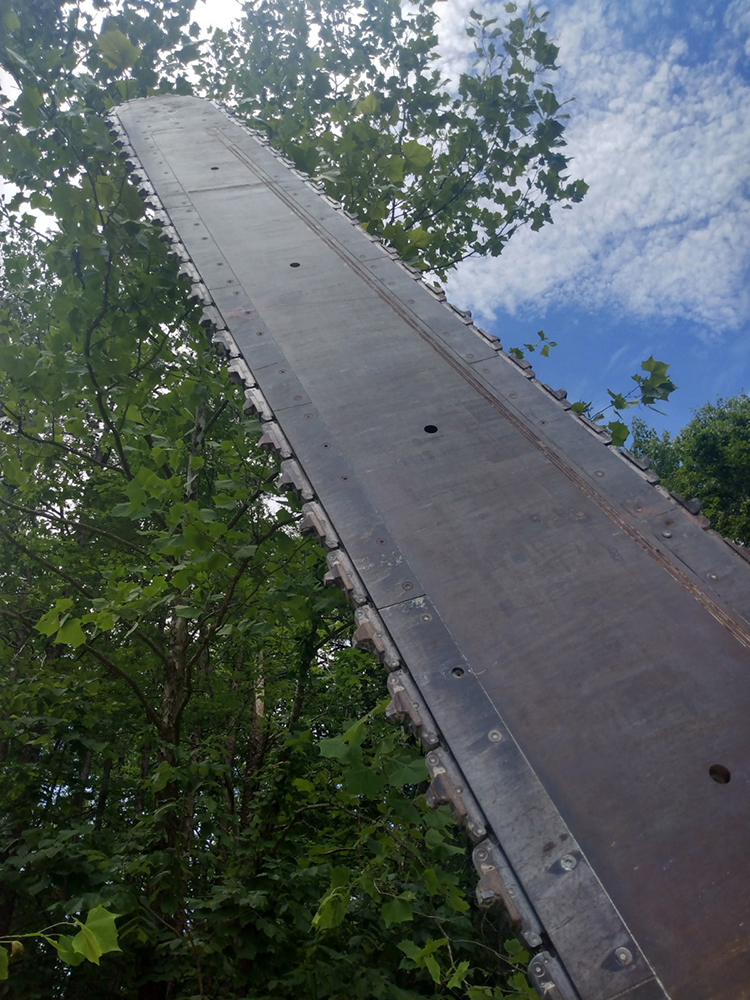
If that looks like a big chainsaw to you, congratulations: that’s pretty much exactly what it is, but the bar is more than fifteen feet long, and the individual carbide teeth are an inch square. They slice into the soapstone and polish it into slabs, aiming for bits that show veining so people will find it an attractive choice for countertops. Here’s a detail of one of the veins, made principally of talc (white) and pyrite (brassy).
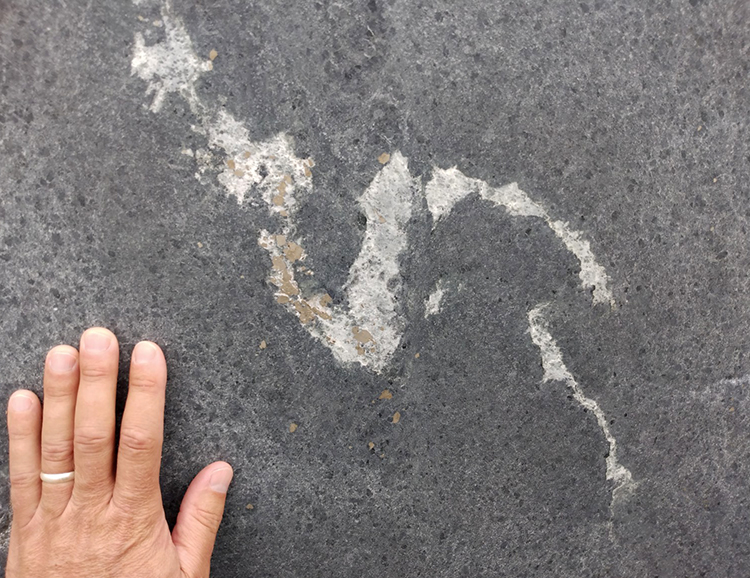
But there was some structure to be seen, too. If you go back to that first photo and take another gander at it, you’ll note some diagonal fractures. Those are a source of some consternation to the quarry operators, since they are planes of weakness that can allow rockslides. Most challenging is when a steeply dipping fracture dips into a quarry wall, daylighting with a big wedge of rock above the fracture surface.

If you look at the fracture surfaces themselves, they show slickensides, so these are actually small faults.
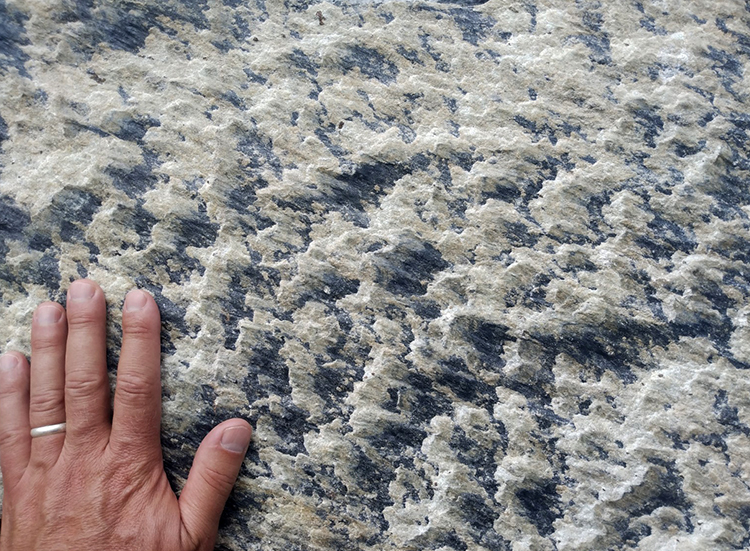
They indicate an oblique sense of motion that presumably accompanied metamorphism. The soapstone is more foliated closer to its margins, where it is in contact with the Lynchburg Group metasediments. The most massive stone in the middle is most valuable economically. Between the foliation and the faults, there’s a lot of soapstone here that doesn’t make it to market – which means plenty for the curious visiting geologist to browse through and select samples from!


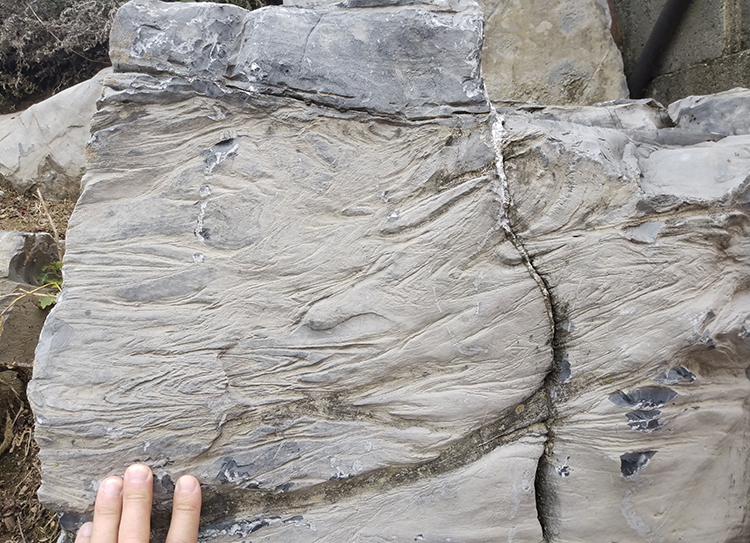
 Callan Bentley is Associate Professor of Geology at Piedmont Virginia Community College in Charlottesville, Virginia. He is a Fellow of the Geological Society of America. For his work on this blog, the National Association of Geoscience Teachers recognized him with the James Shea Award. He has also won the Outstanding Faculty Award from the State Council on Higher Education in Virginia, and the Biggs Award for Excellence in Geoscience Teaching from the Geoscience Education Division of the Geological Society of America. In previous years, Callan served as a contributing editor at EARTH magazine, President of the Geological Society of Washington and President the Geo2YC division of NAGT.
Callan Bentley is Associate Professor of Geology at Piedmont Virginia Community College in Charlottesville, Virginia. He is a Fellow of the Geological Society of America. For his work on this blog, the National Association of Geoscience Teachers recognized him with the James Shea Award. He has also won the Outstanding Faculty Award from the State Council on Higher Education in Virginia, and the Biggs Award for Excellence in Geoscience Teaching from the Geoscience Education Division of the Geological Society of America. In previous years, Callan served as a contributing editor at EARTH magazine, President of the Geological Society of Washington and President the Geo2YC division of NAGT.